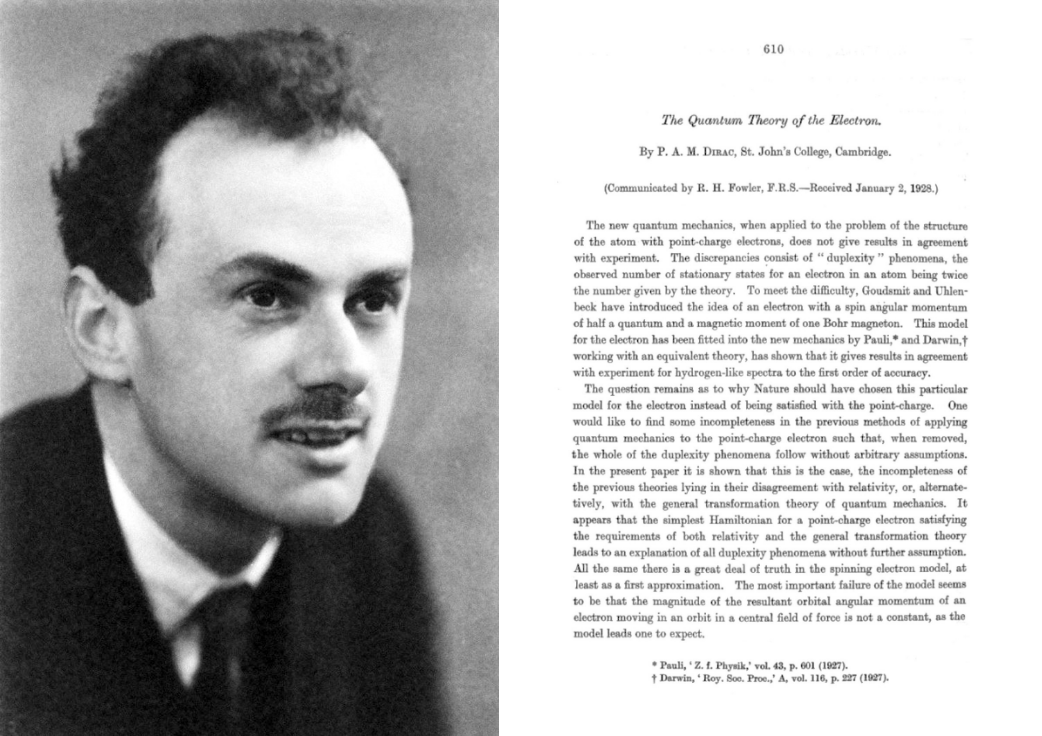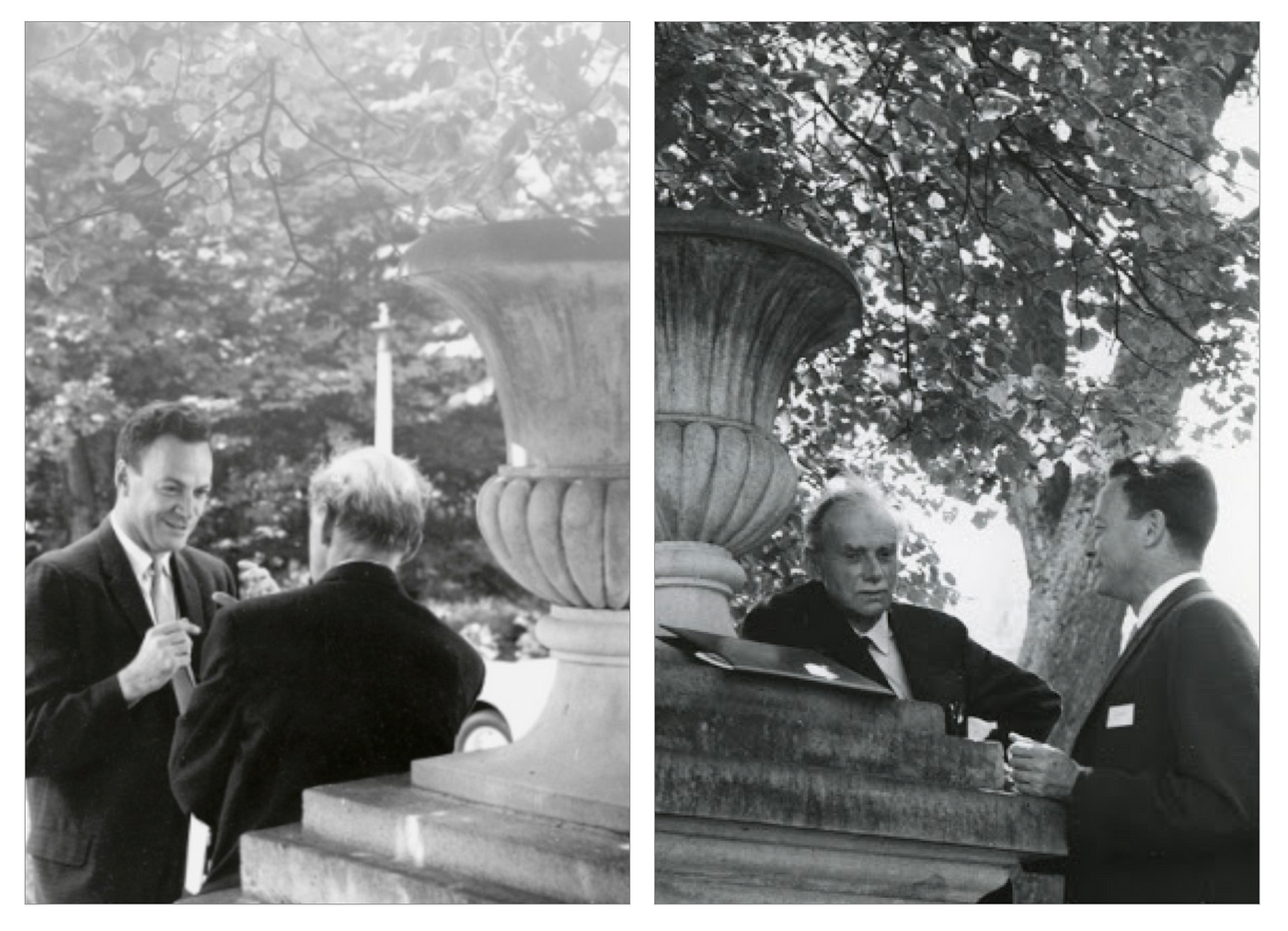When Feynman met Dirac
Beloved late physicist Richard P. Feynman (1918–1988) first met his hero Paul Dirac (1902–1984) during Princeton University’s Bicentennial Celebration in 1946 and then again at least twice, in 1948 and 1962.

“I am Feynman.”
“I am Dirac.”
(Silence)
Beloved late physicist Richard P. Feynman (1918–1988) first met his hero Paul Dirac (1902–1984) during Princeton University’s Bicentennial Celebration in 1946 and then again at least twice, in 1948 and 1962. Most notably, the two came to heads during the so-called Pocono Conferencewhen Feynman gave a lecture on a nascent “Alternative Formulation of Quantum Electrodynamics”, reformulating the theory which had earned Dirac the Nobel Prize in Physics in 1933. A star-studded audience of 28 of the world’s leading physicists attended the conference, including J. Robert Oppenheimer, Niels Bohr, Eugene Wigner, John von Neumann, Enrico Fermi, Hans Bethe and of course, the inventor of the theory himself, Paul Dirac.
Feynman’s reformulation of Dirac’s theory was not well received at Pocono, as Bohr, Teller and Dirac all raised objections. Feynman’s disappointment from the audience’s reaction motivated him to write up his work for publication instead. He did so, and in the next three years went on to publishfour major papers describing his now well-developed theory and its implications:
- Feynman, R.P. (1949). “Space–Time Approach to Quantum Electrodynamics”. Physical Review 76 (6) pp. 769–89.
- Feynman, R.P. (1949). “The Theory of Positrons” in Physical Review 76 (6) pp. 749–759;
- Feynman, R.P. (1950). “Mathematical Formulation of the Quantum Theory of Electromagnetic Radiation” in Physical Review 80 (3) pp. 440–457; and
- Feynman, R.P. (1951). “An Operator Calculus Having Applications in Quantum Electrodynamics” in Physical Review 84 (1) pp. 108–128;
The papers would win Feynman himself the Nobel Prize in Physics alongside Julian Schwinger (1918-1994) and Schin’ichirō Tomonaga (1906-1979) in 1965 for their “fundamental work in quantum electrodynamics with deep-ploughing consequences for the physics of elementary particles”.
This is the story of how Dirac, Feynman’s hero-turned-opponent motivated a life’s work which not only altered the trajectory of modern physics, but also erected Feynman’s legend as one history’s finest scientists.
Estimated reading time is 15 minutes.
Background (1926–1946)

The first formulation of a quantum theory describing how radiation and matter interacted was made by English physicist Paul Dirac in 1926 when he was working under Max Born (1882–1970) at the University of Göttingen. His calculation concerned the coefficient of spontaneous emission of an atom. Dirac described the quantization of the electromagnetic field as an ensemble of harmonic oscillators with the introduction of the concept of creation and annihilation operators. His computation was first published in the 1927 paper “The Quantum Theory of the Emission and Absorption of Radiation” in Proceedings of the Royal Society of London Academy 114 (767) pp. 243–65.
The work would contribute to Dirac being awarded the 1933 Nobel Prize in Physics alongside Erwin Schrödinger for their “discovery of new productive forms of atomic theory”. With further developments by Pauli, Wigner, Jordan, Heisenberg and Fermi, by the 1930s, leading quantum physicists had come to believe that it would be possible to perform computations for any and all physical processes involving photons and particles under charge. Of Dirac’s discovery, Feynman in his Dirac Memorial Lecture would later described how, for the first time (Feynman & Weinberg, 1987):
Dirac with his relativistic equation for the electron was the first to, as he put it, wed quantum mechanics and relativity together. — Richard P. Feynman (1986)
Although revolutionary at its inception in the 20s and early 30s, by the mid 1940s it was however generally accepted among leading scientists that the theory of quantum electrodynamics — which Dirac had proposed— was suffering from mathematical flaws. In particular, the then-current state of the theory lead to infinite integrals in perturbation theory of higher orders than the first. This had been pointed out as early as 1930 by Oppenheimer, in the paper “Note on the Theory of the Interaction of Field and Matter” in Physical Review 35 (5) pp. 461–77, but would not be addressed properly until further studies were published by Felix Bloch & Arnold Nordsieck (1937) and Victor Weisskopf (1939).
Following the interruption of Second World War, improvements in microwave technology had made it possible to conduct more precise experiments, measuring the shift of the levels of hydrogen atoms now known as the Lamb shift, as well as the magnetic moment of electrons. The discoveries revealed further weaknesses of the theory. It was at the height of this tension that Feynman and Dirac would first meet.
Their First Meeting (1946)
“I have an equation. Do you have one too?”
Feynman claimed these were the first words spoken to him by Dirac when the two men first met in 1946. At the time, Princeton University was in the midst of celebrating its two-hundredth anniversary. Feynman was invited to introduce his hero and lead a discussion about the great man’s recent work. Dirac had been invited to to speak on elementary particles during a session on the future of nuclear science following the war. As Gleick (1992 p. 226) writes, Feynman disliked the work Dirac was presenting, which he considered to be a re-statement of work that lead to already well-known difficulties in quantum electrodynamics:
“It struck him as backward-looking in its Hamiltonian energy-centered emphasis — a dead end.” — Gleick (1992)
Feynman addressed the crowd before introducing Dirac, in the midst of “so many nervous jokes that Niels Bohr […] stood up and criticized him for his lack of seriousness” (Gleick, 1992). He closed on a heartfelt remark somewhat in conflict with the message of Dirac’s coming lecture, addressing the unsettled state of the theory of quantum electrodynamics:
“We need an intuitive leap at the mathematical formalism, such as we had in the Dirac electron theory […] We need a stroke of genius”
Then, as the day wore on (Gleick, 1992):
Feynman looked out the window and saw Dirac lolling on a patch of grass and gazing at the sky. He had a question that he had wanted to ask Dirac since before the war. He wandered out and sat down. A remark in a 1933 paper of Dirac's had given Feynman a crucial clue toward his discovery of a quantum-mechanical version of the action in classical mechanics. "It is now easy to see what the quantum analogue of all this must be;" Dirac had written, but neither he nor anyone else had pursued this clue until Feynman discovered that the "analogue" was, in fact, exactly proportional. There was a rigorous and potentially useful bond.Now, he asked Dirac whether the great man had known all along that the two quantities were proportional. "Are they?" Dirac said.
Feynman said yes, they were. After a silence Dirac walked away.- Excerpt, Genius by James Gleick (1992)
Their Second Meeting (1948)
Their first interaction — albeit probably nothing out of the ordinary for Dirac, who was known for his eccentricity — likely disappointed the notoriously gregarious Feynman, who had been wanting to discuss Dirac’s work since he first got into physics.
The two mens’ paths would not cross again until a few years later, when they both attended the Pocono Conference arranged by J. Robert Oppenheimerfor the National Academy of Sciences. Oppenheimer and Dirac had been close friends since the mid-1920s when they both worked under Max Born in Göttingen. Feynman and Oppenheimer’s relationship traced back to Los Alamos and the Manhattan Project, where the former had been in charge of the group responsible for the theoretical work on the proposed uranium hydride bomb, under Oppenheimer’s directorship. Even before the war ended, Oppenheimer had grown so impressed by the young Feynman’s work that he in 1943 wrote an unsolicited letter of recommendation to the Chairman of the Physics Department at UC Berkeley suggesting he offer a position to Feynman for after the war, writing:
He is by all odds the most brilliant young physicist here, and everyone knows this. He is a man of thoroughly engaging character and personality, extremely clear, extremely normal in all respects, and an excellent teacher with a warm feeling for physics in all its aspects. He has the best possible relations both with the theoretical people of whom he is one, and with the experimental people with whom he works in very close harmony.[...]I feel that he would be a great strength for our department, tending to tie together its teaching, its research and its experimental and theoretical aspects. I may give you two quotations from men with whom he has worked. Bethe has said that he would rather lose any two other men than Feynman from this present job, and Wigner said, "He is a second Dirac, only this time human."[...]With every good wish,
Robert Oppenheimer- Excerpt, Letter from Oppenheimer to Birge (November 4th, 1943)
The Pocono conference (1948) succeeded the now somewhat legendary Shelter Island Conference (1947) on “The Foundations of Quantum Physics” a year before. The first major post-war physics conference, it was later deemed by Oppenheimer as the “most successful scientific meeting he had ever attended”. Feynman later recalled to science historian Jagdish Mehra that
“There have been many conferences in the world since, but I’ve never felt any to be as important as this. […] The Shelter Island Conference was my first conference with big men […] I had never gone to one like this in peacetime”
Although discussed at the Shelter Island conference, the mathematical problems tripping up quantum electrodynamics were in 1947 completely overshadowed by the achievements of experimentalists and their discovery of the Lamb shift and the first measurement of the magnetic moment of the electron (Mehra, 1994).
Nevertheless, the Pocono meeting gathered on March 30th in the picturesque Pocono Mountains of Pennsylvania “in a lounge under a tarnished green clock tower with a view over a golf course and fifty miles of rolling woodlands” (Gleick, 1992). Feynman’s talk, entitled An Alternative Formulation of Quantum Electrodynamics was to occur on day two. Preceding him was American physicist Julian Schwinger, who proposed, for the first time, a complete theory of quantum electrodynamics which met the criteria of both “relativistic invariance” and “gauge invariance”, attempting to resolve the infinite-energies issue that had been plaguing quantum electrodynamics since its formulation by Dirac and others almost twenty years prior.

Schwinger’s theory built its intuition on the earlier work of Hans Bethe(1906–2005), published after attending the Shelter Island conference the year before. Bethe’s paper, “The Electromagnetic Shift of Energy Levels” established a procedure later known as renormalization where the statistical mechanics of fields and the theory of self-similar geometric structures are used to compensate for the effects of self-interactions in quantum field theory.
Schwinger’s contribution was to further the work of Bethe. His lecture was highly formal, both in its structure and content. “He introduced a difficult new notation and set about to derive a sampling of specific results for such ‘applications’ as the interaction of an electron with its own field.” (Gleick, 1992). While underway, Bohr broke in with a question. This annoyed Schwinger, who cut him off and moved forward. At the end of his lecture — which lasted for six hours — Bethe noticed that Schwinger’s formal, mathematical approach had silenced the audience, and so suggested that Feynman pursue a similar structure. Bethe had been the head of the theoretical division at Los Alamos where Feynman worked during the Manhattan Project. In Oppenheimer’s letter to Birge in 1943, he is quoted as having said about Feynman that “he would rather lose any two other men than Feynman”. Trusting his former boss Bethe’s intuition, Feynman began his lectures with equations, stating (Gleick, 1992):
“This is a mathematical formulation which I will now show you produces all the results of quantum mechanics”
Standing before his former boss and teacher Bethe, Bethe’s former boss Oppenheimer, and his idols Dirac and Fermi, among others, Feynman proceeded.
Now famous as one of the most gifted science communicator of all time, there Feynman stood, haphazardly delivering an unrehearsed lecture containing “a patchwork of guesses and intuition”, described by Schwinger (who was seeing Feynman’s work for the first time) as closer to engineering than physics. The audience grew rowdy.
“It struck Feynman that everyone had a favorite principle or theory and he was violating them all” — Gleick (1992)
Teller broke in, arguing that he was violating the exclusion principle. Then Bohr, who had often sought out Feynman at Los Alamos “for someone to argue with”, stood up and delivered a humiliating lecture that seemed to convey Feynman’s lack of understanding of even elementary physics.
Finally, Dirac raised his hand.
“Is it unitary?”
Feynman was drawing unfamiliar diagrams on the blackboard. He showed a particle of antimatter going backward in time. This mystified Dirac, the man who had first predicted the existence of antimatter. Dirac now asked a question about causality: "Is it unitary?" Unitary! What on earth did he mean?"I'll explain it to you," Feynman said, "and then you can see how it works, then you can tell me if it is unitary." He went on, and from time to time he thought he could still hear Dirac muttering, "Is it unitary?".- Excerpt, Genius: The Life and Science of Richard Feynman by James Gleick (1992)
Feynman didn’t even know what Dirac meant. Hoping that moving on to working out positrons would help them understand, he continued. Dirac broke in with the same inquiry again: “Is it unitary?”.
“Is what unitary?” Feynman replied.
“Is the matrix that carries you from past to future unitary”
This didn’t help Feynman much, who capitulated:
“Since I had tracks going backwards and forwards in time I don’t know whether it is unitary”.
The answer was not to the satisfaction of the audience, who ultimately brushed off Feynman’s lecture and instead singled in on Schwinger’s presentation as the highlight of the conference.
“I had too much stuff. My machines came from too far away”.
Feynman later recalled.
Feynman’s work on Quantum Electrodynamics
Although he did not have an equation for Dirac there at their first meeting in 1946, Feynman after the conference returned back to Cornell University where he held a position as an Assistant Professor of Physics at the time. In the days following the talk he had compared his results with Schwinger’s and realized that “they were both traversing different trajectories on the mountain of truth” (Jogalekar, 2018).
Within a year, he had formalized his ideas and written a paper that summarized his own view of how quantum mechanics work. The paper is entitled
- Feynman, R.P. (1948). “A Relativistic Cut-Off for Classical Electrodynamics” in Physical Review 74 (8) pp. 939–946;
Feynman would go on to publish another four major papers in the next three years, all considered classics, dealing with various aspects of quantum electrodynamics:
- Feynman, R.P. (1949). “Space–Time Approach to Quantum Electrodynamics”. Physical Review 76 (6) pp. 769–89.
- Feynman, R.P. (1949). “The Theory of Positrons” in Physical Review 76 (6) pp. 749–759;
- Feynman, R.P. (1950). “Mathematical Formulation of the Quantum Theory of Electromagnetic Radiation” in Physical Review 80 (3) pp. 440–457; and
- Feynman, R.P. (1951). “An Operator Calculus Having Applications in Quantum Electrodynamics” in Physical Review 84 (1) pp. 108–128;
The work would go on to earn Feynman the Nobel Prize in Physics alongside Schwinger (1918–1994) and a Japanese physicist, Schin’ichirō Tomonaga(1906–1979) who had worked out a similar theory of his own.
Their Third Meeting (1962)

Feynman and Dirac would, as far as we know, only meet one other time, at the International Conference on Relativistic Theories of Gravitation in Warsaw, Poland in 1962. The conference was organized by Leopold Infeld. Their conversation, as overheard by a nearby physicist, was so remarkable that he jotted it down (Gleick, 1992 pp. 228):
F: I am Feynman.
D: I am Dirac.(Silence)F: It must be wonderful to be the discoverer of that equation.
D: That was a long time ago.(Pause)D: What are you working on?
F: Mesons.D: Are you trying to discover an equation for them?
F: It is very hard.D: One must try.
The Dirac Memorial Lecture (1986)
Paul Dirac died in 1984 at the age of 82 years old. Two years later, Feynman was invited to give one of three Dirac Memorial Lectures. He did so, with a lecture entitled “Elementary Particles and the Laws of Physics”, which he opened as follows:
When I was a young man, Dirac was my hero. He made a new breakthrough, a new method of doing physics. He had the courage to simply guess at the form of an equation, the equation we now call the Dirac equation, and to try to interpret it afterwards.
Feynman’s lecture was published in a book of the same name, Elementary Particles and the Laws of Physics, published in 1987 by Cambridge University Press (Feynman & Weinberg, 1987). The lecture is available in its entirety below. Feynman begins speaking at 3 minutes, 45 seconds:
T





